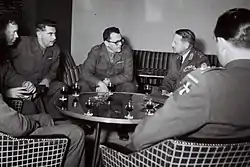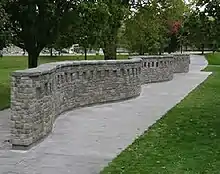E. L. M. Burns
Lieutenant General Eedson Louis Millard "Tommy" Burns, CC, DSO, OBE, MC, CD (June 17, 1897 – September 13, 1985) was a senior officer of the Canadian Army and a diplomat. His military career has, for the most part, been criticised by historians as showing he was "simply incapable of commanding a higher formation."[2]
E. L. M. Burns | |
|---|---|
.jpg.webp) | |
| Nickname(s) | "Tommy" "Smiling Sunray" [1] |
| Born | June 17, 1897 Montreal, Quebec, Canada |
| Died | September 13, 1985 (aged 88) |
| Allegiance | Canada |
| Service/ | Canadian Army |
| Years of service | 1914–1959 |
| Rank | Lieutenant General |
| Commands held | I Canadian Corps 5th Canadian Armoured Division 2nd Canadian Infantry Division 4th Canadian Armoured Brigade |
| Battles/wars | World War I World War II |
| Awards | Companion of the Order of Canada Distinguished Service Order Officer of the Order of the British Empire Military Cross Canadian Forces Decoration |



Early education

E.L.M. Burns was born on June 17, 1897 in Montreal, Quebec. His father was a militia staff officer, a member of the Corps of Guides. He served with the 17th Duke of York's Royal Canadian Hussars (17th D.Y.R.C.H.). He had risen to the rank of signal sergeant by 1913.[3] "Tommy" Burns, student # 1032 graduated from the Royal Military College of Canada in Kingston, Ontario in 1914. He joined the Royal Canadian Engineers, into which he was commissioned as a second lieutenant in 1915.
World War I
Burns served in Canada until March 1916 when he went overseas with the 3rd Canadian Division Signal Company which, was composed of engineers. He fought on the Western Front with the Royal Canadian Engineers from 1916 to 1918. He became a staff officer with the 9th Brigade in March 1917, dealing with supply and personnel. He became a "staff learner" and acted as liaison officer between forward battalions and brigade headquarters. He returned to Canada in 1919 and was stationed at St. John as an engineer officer.[3]
Between the wars
Burns attended the School of Military Engineering, Chatham, England, for eighteen months. He was an instructor at the Royal Military College of Canada in Kingston, Ontario. He returned to Halifax and served on duty during the miners' strike at Glace Bay. He worked in the Survey Department in Ottawa. In 1924, he was appointed as an instructor at RMC in field engineering. He attended the Staff College, Quetta, British India and returned to Quebec, Canada in 1930.[3] In 1939, as a lieutenant colonel, he attended the Imperial Defence College in London, England.
World War II
During World War II Burns successively commanded the 4th Canadian Armoured Brigade, the 1st Canadian Infantry Division, the 5th Canadian (Armoured) Division (January 1944 to March 1944), and then finally I Canadian Corps (March 1944 until November 1944). His performance as a corps-level commander proved to be controversial, despite the successes of the Canadian forces in the Italian Campaign, and so he was replaced as commander of I Canadian Corps by Lieutenant-General Charles Foulkes.
Later life
Burns served as Deputy Minister of Veterans’ Affairs. He served as a President of the UNAC during the 1950s. He played a critical role in the Middle East peace process from 1954 to 1959. He was instrumental in developing UN peacekeeping. As Chief of Staff in 1954, United Nations Truce Supervision Organization (UNTSO) was designed to maintain the General Armistice Agreements until permanent peace could be formulated.
Burns served as a Chief of Staff of the Truce Supervision Organization in Palestine (1954–56) and was thus nearby when the Suez Crisis of 1956 occurred. He then led UNEF as Force Commander from November 1956 to December 1959. He was Canada's principal disarmament negotiator from 1960–68.
Burns held the chair of Strategic Studies at the Norman Paterson School for International Affairs, Carleton University from 1969–75. He wrote "Between Arab and Israeli" (1962); "General Mud: Memoirs of Two World Wars" (1970) and "Defense in the Nuclear Age" (1976).
Honours

Burns was awarded the Military Cross for maintaining communications under heavy fire, and, for the same action at the Somme, his non-commissioned officers received Military Medals.
In 1967 Burns was made a Companion of the Order of Canada for his services to Canada at home and abroad. He was described as a Former Chief of General Staff and Canadian adviser on disarmament in Geneva. In 1970, he received an honorary doctorate from Sir George Williams University, which later became Concordia University.[4]
Burns was the 1981 recipient of the Pearson Medal of Peace for his work in the military of Canada. He is a 2010 induction to the Wall of Honour at the Royal Military College of Canada. There is also a park located in Nepean named after him.
A mannequin at the Royal Military College of Canada wears "Tommy" Burns' khaki army uniform jacket, covered with medals and wrapped with a Sam Browne belt.
Bibliography
- Burns, Lieutenant-General E.L.M. (1962) Between Arab and Israeli. George G. Harrap.
Notes
- canadiansoldiers.com
- Lofgen, 2006
- Military Oral History collection
- "Honorary Degree Citation – Eedson Louis Millard Burns* | Concordia University Archives". archives.concordia.ca. Retrieved 2016-03-30.
Further reading
External links
| Wikimedia Commons has media related to E. L. M. Burns. |
- "Lieutenant-General E.L.M. Burns". Juno Beach Centre. Retrieved January 30, 2005.
- "Lieutenant-General E.L.M. Burns".
- "Lieutenant-General E.L.M. Burns oral history interview".
- Archived February 4, 2012, at the Wayback Machine
- Eedson Louis Millard Burns at The Canadian Encyclopedia
- Office of the Governor General of Canada. Order of Canada citation. Queen's Printer for Canada. Retrieved 24 May 2010
- Burns, E.L.M. General mud : memoirs of two World Wars. Toronto : Clarke, Irwin, 1970. 254 p.
- Details of war service from generals.dk
- Details of war service from ordersofbattle.com
- Concordia University Honorary Degree Citation, June 1970, Concordia University Records Management and Archives
| Military offices | ||
|---|---|---|
| Preceded by Vagn Bennike |
United Nations Truce Supervision Organization August, 1948 – June, 1953 |
Succeeded by Byron V. Leary |